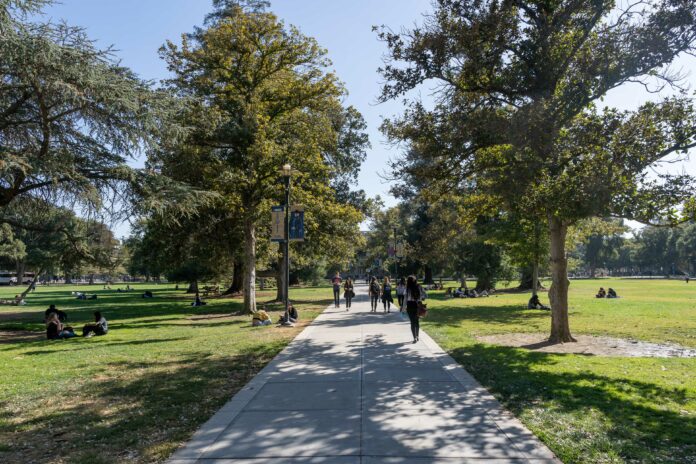Universities and prospective students alike must prepare for an uncertain future
If you’re a UC Davis student, odds are you’re reading this at home.
The current COVID-19 crisis has led to the cancellation of in-person lectures across the nation. From Berkeley to Ann Arbor to Ithaca, university campuses and the college towns dependent on them have shuttered their doors. The answer to their economic woes caused by the pandemic don’t appear to be arriving anytime soon.
Colleges across the country remain skeptical of the possibility of in-person instruction returning this fall. A number of them, including Boston University and Stanford, are considering pushing the start of in-person instruction to Jan. 2021, with the latter proposing an entirely modified academic year that would begin with a “fall” quarter that same month. UC Berkeley has already stated its intentions to offer the option of remote instruction, even if in-person lectures return next semester –– a move that is likely to be replicated by universities across the nation. More and more, the prospect of ordinary academic instruction next year looks questionable at best.
The economic repercussions of COVID-19 are likely to devastate college finances as well. Even now, schools are contending with the unexpected financial pitfalls of remote instruction. Accurate numbers on just how much colleges are losing during this crisis are hard to come by, but the University of Michigan, for example, estimates losses between $400 million and $1 billion through the end of the year. The Los Angeles Times likewise reported that the UC system spent $558 million in unexpected costs in March alone.
Should mandatory remote instruction continue through fall, colleges are likely to see a substantial dropoff in the size of their freshman classes, intensifying an already troubling trend. College enrollment has previously declined for eight straight years, with nationwide enrollment dropping by about 11% in that time period. Now it’s likely to shrink even more.
Across the nation, students and their families are debating the merits of attending college, especially when that education is now all but guaranteed to be remote. Reductions in scholarships and financial aid are likely to harm lower-income students, and there is a strong possibility that even current enrollees may not return next fall. For many prospective students, college is looking like a gamble and a heavy investment that will almost assuredly lack the usual coming of age experiences of university life.
Consequently, high school seniors across the nation are debating just what they plan to do next year. Some are considering taking a gap year, while others are turning down their dream schools to save money and attend somewhere closer to home. Many college students too, are evaluating their future plans, questioning whether or not remote instruction is giving them what they’re paying for.
Elsewhere, another higher education experience is also crumbling under the weight of the COVID-19 pandemic –– collegiate athletics. For the vast majority of NCAA Division I schools, particularly among Group of 5 and FCS programs like UC Davis, athletic funds are accrued through tuition fees, NCAA payouts and lucrative game contracts against bigger name opponents. The cancellation of the NCAA men’s basketball tournament this year meant that the NCAA reduced its annual payout to schools from $600 million to $225 million, a gut-punch likely to affect mid-major programs more than wealthy Power 5 teams. But now, even the latter is wrestling with the possible loss of its own multibillion-dollar revenue generator –– college football.
With the likelihood of college football this upcoming fall diminishing day by day, athletic directors have struggled to grapple with cash-stricken budgets –– some even proposing a spring football season. The dependence of so-called “Olympic sports” programs, like swimming or track and field, on money generators like football and basketball have led athletic departments to consider cutting certain non-revenue sports. This has already occurred at the University of Cincinnati and elsewhere. One Power 5 athletic director went as far as saying there was “no point” in planning a football-less budget, as the financial implications would be too devastating to even consider.
A decline in overall enrollment would mean a loss of funding for more than just sports. Hiring freezes and staff furloughs have impacted academics and service workers alike, with substantial pay reductions likely to remain permanent. In many cases, students dependent on campus employment or crucial services, like food banks and mental health centers, are now largely deprived of these forms of assistance. Delaying these resources, even if it may prove medically necessary, could have dire consequences for a vast number of young Americans.
There are still tough times ahead. Even if COVID-19 dies down with the summer heat, experts fully expect the virus to return in strength next fall. When it does return, let’s make sure we’ve made the proper preparations to handle another school year in the heart of a pandemic. What this contingency plan consists of remains to be seen, but we better start working on it now.
Written by: Brandon Jetter — brjetter@ucdavis.edu
Disclaimer: The views and opinions expressed by individual columnists belong to the columnists alone and do not necessarily indicate the views and opinions held by The California Aggie





